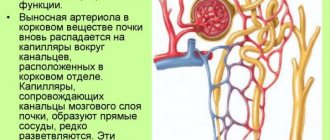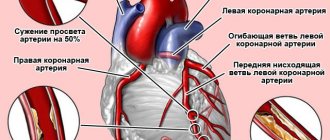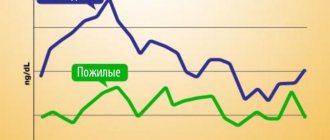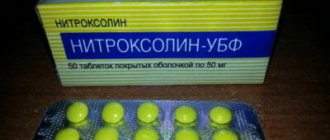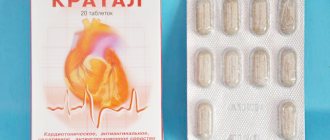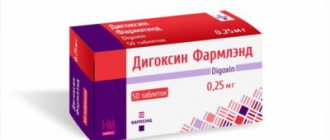Bisogamma®
When prescribing bisoprolol, the patient must inform the doctor about all the medications he is taking. This information will allow the doctor to take into account possible drug interactions and give the patient the necessary recommendations on the rules and order of their use. The effectiveness and tolerability of bisoprolol may be affected by the simultaneous use of other medications.
Not recommended combinations:
— In the treatment of chronic heart failure, the simultaneous administration of quinidine, lidocaine, disopyramide, phenytoin, propafenone, flecainide and other class I antiarrhythmic drugs is not recommended; this combination with bisoprolol can reduce myocardial contractility and AV conductivity;
— Diltiazem, verapamil and other blockers of “slow” calcium channels can cause a decrease in myocardial contractility and impaired AV conduction. Intravenous administration of verapamil to patients taking beta-blockers can lead to severe arterial hypotension and AV block;
— Clonidine, moxonidine, methyldopa, rilmenidine and other centrally acting antihypertensive drugs can cause a decrease in cardiac output and heart rate and lead to vasodilation against the background of a decrease in central sympathetic tone. The likelihood of rebound hypertension increases with abrupt discontinuation of the drug before discontinuation of beta-blockers.
Drugs in combination with which the administration of Bisogamma® requires caution:
Felodipine, nifedipine, amlodipine and other dihydropyridine derivatives increase the risk of arterial hypotension; in chronic heart failure, a subsequent deterioration in the contractile function of the heart is possible;
Non-steroidal anti-inflammatory drugs - reduce the antihypertensive effect of bisoprolol;
Amiodarone and other class III antiarrhythmic drugs may increase AV conduction disturbances;
Beta-blockers for topical use, including eye drops for the treatment of glaucoma - increase the systemic effect of bisoprolol;
Parasympathomimetics - may increase the risk of developing bradycardia and impaired AV conduction;
Oral hypoglycemic agents and insulin increase their clinical effect; symptoms of hypoglycemia (tachycardia) can be suppressed or masked. Such interactions are more likely when using non-selective beta-blockers;
Phenytoin when administered intravenously, agents for general and inhalation anesthesia - increase the likelihood of cardiodepressive effects, which can lead to arterial hypotension;
Cardiac glycosides - can increase the impulse conduction time and lead to the development of bradycardia;
Tricyclic antidepressants, phenothiazines, barbiturates and other drugs with antihypertensive effect can increase the antihypertensive effect of bisoprolol;
The clearance of lidocaine and xanthines (except theophylline) may decrease due to a possible increase in their concentrations in the blood plasma;
Mefloquine - increases the likelihood of developing bradycardia;
Monoamine oxidase (MAO) inhibitors (except MAO B inhibitors) - potentiate the hypotensive effect of the drug and can cause the development of a hypertensive crisis;
The combination of the drug with isoprenaline, dobutamine and other beta-agonists leads to a decrease in the clinical effect of both drugs. Simultaneous use with bisoprolol of adrenergic agonists that affect alpha and beta adrenergic receptors (norepinephrine, epinephrine) leads to an increase in blood pressure. Such interactions are more likely when using non-selective beta-blockers;
Iodine-containing radiopaque diagnostic agents for intravenous administration increase the risk of anaphylactic reactions;
Non-hydrogenated ergot alkaloids increase the risk of developing peripheral circulatory disorders. Sulfasalazine increases the concentration of bisoprolol in plasma, rifampicin shortens the half-life.
Bisogamma
Special conditions
Monitoring of patients taking the drug Bisogamma® includes measuring heart rate and blood pressure (at the beginning of treatment - daily, then once every 3-4 months), conducting an ECG, determining blood glucose levels with concomitant diabetes mellitus (once every 4-5 months). months). In elderly patients, it is recommended to monitor renal function (once every 4-5 months). The patient should be taught how to calculate heart rate and instructed about the need for medical consultation if the heart rate is less than 50 beats/min. Before starting treatment, it is recommended to conduct a study of external respiratory function in patients with a burdened bronchopulmonary history. In approximately 20% of patients with angina, beta blockers are ineffective. The main causes are severe coronary atherosclerosis with a low ischemic threshold (heart rate less than 100 beats/min) and increased end-diastolic volume of the left ventricle, which impairs subendocardial blood flow. When using the drug in patients with pheochromocytoma, there is a risk of developing paradoxical arterial hypertension (if effective blockade of β-adrenergic receptors is not previously achieved). In case of thyrotoxicosis, bisoprolol can mask certain clinical symptoms of thyrotoxicosis (for example, tachycardia). Abrupt withdrawal of Bisogamma® in patients with thyrotoxicosis is contraindicated, as it can increase symptoms. In diabetes mellitus, Bisogamma® can mask tachycardia caused by hypoglycemia. Unlike non-selective beta-blockers, it practically does not enhance insulin-induced hypoglycemia and does not delay the restoration of blood glucose concentrations to normal levels. It is possible that the severity of the hypersensitivity reaction may increase and there will be no effect from usual doses of epinephrine against the background of a burdened allergic history. If planned surgical treatment is necessary, Bisogamma® should be discontinued 48 hours before the start of general anesthesia. If the patient took the drug before surgery, he should select a drug for general anesthesia with minimal negative inotropic effects. Reciprocal activation of the vagus nerve can be eliminated by intravenous atropine (1-2 mg). Medicines that reduce the reserves of catecholamines (including reserpine) can enhance the effect of beta-blockers, so patients taking such combinations of drugs should be under constant medical supervision for timely monitoring of a pronounced decrease in blood pressure or bradycardia. Patients with bronchospastic diseases can be prescribed cardioselective adrenergic blockers in case of intolerance and/or ineffectiveness of other antihypertensive drugs. An overdose is dangerous due to the development of bronchospasm. If increasing bradycardia (less than 50 beats/min), a pronounced decrease in blood pressure (systolic blood pressure below 100 mm Hg), or AV blockade is detected in elderly patients, it is necessary to reduce the dose or stop treatment. It is recommended to discontinue therapy if depression develops.
Bisogamma, 5 mg, film-coated tablets, 30 pcs.
Monitoring of patients taking bisoprolol should include measurement of heart rate and blood pressure (at the beginning of treatment - daily, then - once every 3-4 months), an ECG, determination of blood glucose levels in patients with diabetes mellitus (once every 4-5 months). months). In elderly patients, it is recommended to monitor renal function (once every 4–5 months).
The patient should be taught how to calculate heart rate and instructed about the need for medical consultation if heart rate is <50 beats/min.
Before starting treatment, it is recommended to conduct a study of external respiratory function in patients with a burdened bronchopulmonary history.
In approximately 20% of patients with angina, beta blockers are ineffective. The main causes are severe coronary atherosclerosis with a low ischemic threshold (heart rate <100 beats/min) and increased left ventricular end-diastolic volume, impairing subendocardial blood flow.
Beta blockers are less effective in smokers.
Patients using contact lenses should take into account that during treatment the production of tear fluid may decrease.
When used in patients with pheochromocytoma, there is a risk of developing paradoxical arterial hypertension (if effective alpha-blockade is not previously achieved).
In case of thyrotoxicosis, bisoprolol can mask certain clinical signs of thyrotoxicosis (for example, tachycardia). Abrupt withdrawal in patients with thyrotoxicosis is contraindicated because it can increase symptoms.
In diabetes mellitus, it can mask tachycardia caused by hypoglycemia. Unlike non-selective beta-blockers, it practically does not enhance insulin-induced hypoglycemia and does not delay the restoration of blood glucose concentrations to normal levels.
When taking clonidine concomitantly, it can be discontinued only a few days after bisoprolol is discontinued.
It is possible that the severity of the hypersensitivity reaction may increase and there will be no effect from usual doses of epinephrine against the background of a burdened allergic history.
If planned surgical treatment is necessary, the drug should be discontinued 48 hours before the start of general anesthesia. If the patient took the drug before surgery, he should select a drug for general anesthesia with minimal negative inotropic effect.
Reciprocal activation of the vagus nerve can be eliminated by intravenous atropine (1–2 mg).
Drugs that reduce catecholamine reserves (including reserpine) can enhance the effect of beta-blockers, so patients taking such combinations of drugs should be under constant medical supervision to detect a pronounced decrease in blood pressure or bradycardia.
Patients with bronchospastic diseases can be prescribed cardioselective adrenergic blockers in case of intolerance and/or ineffectiveness of other antihypertensive drugs. An overdose is dangerous due to the development of bronchospasm.
If increasing bradycardia (<50 beats/min), a pronounced decrease in blood pressure (sBP <100 mm Hg), or AV blockade is detected in elderly patients, it is necessary to reduce the dose or stop treatment.
It is recommended to discontinue therapy if depression develops.
Treatment should not be abruptly interrupted due to the risk of developing severe arrhythmias and myocardial infarction. Cancellation is carried out gradually, reducing the dose over 2 weeks or more (by 25% in 3-4 days). It should be discontinued before testing the content of catecholamines, normetanephrine and vanillylmandelic acid in the blood and urine, and titers of antinuclear antibodies.
During the treatment period, care must be taken when driving vehicles and engaging in other potentially hazardous activities that require increased concentration and speed of psychomotor reactions.
Similar drugs:
- Papaverine Oral tablets
- Magnesium sulfate Powder for oral suspension
- Concor Oral tablets
- Cefavora (CEFAVORA) Homeopathic drops
- Magnesium sulfate Substance-powder
- Celandine grass (Chelidonii majoris herba) Vegetable raw materials
- Barbovalum Oral drops
- Betaloc ZOK Oral tablets
- Prestance Oral tablets
- Enap Oral tablets
** The Drug Directory is intended for informational purposes only. For more complete information, please refer to the manufacturer's instructions. Do not self-medicate; Before starting to use the drug Bisogamma, you should consult a doctor. EUROLAB is not responsible for the consequences caused by the use of information posted on the portal. Any information on the site does not replace medical advice and cannot serve as a guarantee of the positive effect of the drug.
Are you interested in the drug Bisogamma? Do you want to know more detailed information or do you need a doctor's examination? Or do you need an inspection? You can make an appointment with a doctor - the Euro lab is always at your service! The best doctors will examine you, advise you, provide the necessary assistance and make a diagnosis. You can also call a doctor at home . Euro lab clinic is open for you around the clock.
** Attention! The information presented in this medication guide is intended for medical professionals and should not be used as a basis for self-medication. The description of the drug Bisogamma is provided for informational purposes and is not intended for prescribing treatment without the participation of a doctor. Patients need to consult a specialist!
If you are interested in any other drugs and medications, their descriptions and instructions for use, information about the composition and form of release, indications for use and side effects, methods of use, prices and reviews of drugs, or you have any other questions and suggestions - write to us, we will definitely try to help you.
